
TOYOTA Corolla 5 Doors
Generations Timeline, Specs and Pictures
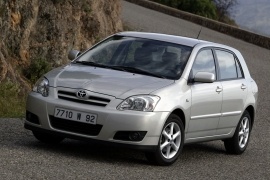
Toyota launched the ninth Corolla generation in 2000 and, four years later, it introduced the facelifted version for the entire range, preparing it for the Euro 4 Emission standards.
The Corolla was always a strong competitor in the compact segment. While in the U.S. had a smaller niche segment, in Europe, it had to fight against the best of the compact vehicles, such as the VW Golf, Renault Megane, Opel/Vauxhall Astra, and Ford Focus. Another important contender on the market also was the Honda Civic 5-door. In 2004, Toyota had to do a facelift to improve the compact Corolla, which didn’t look too good in the sales charts.
Since there was little to do with the exterior look, the Corolla 5-door was improved in the technical department. The new smoked headlights and a reshaped bumper aimed for a sportier look. But the rest of the greenhouse, with a more upright windshield than the other contenders, didn’t help. A revised grille with one horizontal slat instead of a black mesh grille improved the car’s appearance.
Inside, the Corolla was fitted with an option for sportier-look seats but without big bolstering on the side to help during fast cornering. The simple layout of the dashboard was not as bold as those offered by the other competitors. Toyota’s design philosophy was not so appealing for European customers.
In the technical department, the Corolla offered a choice of five diesel and gasoline engines. A five-speed automatic gearbox was available on specific models, while the five-speed manual was fitted as standard.
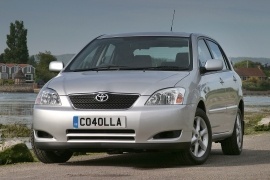
Since its introduction on the market in 1968, the Toyota Corolla suffered many mechanical and exterior design changes.
Offered in different body styles such as a hatchback, a coupe, a wagon and a sedan, the Corolla enjoyed great success mostly due to its reliability.
With many competitors in the segment, Toyota decided to reveal a more modern Corolla to compete with the Ford Focus, the Honda Civic and the Hyundai Elantra.
Under the hood, the Corolla was fitted with a punchy and smooth-revving 1.8-liter 4 cylinder unit that developed 125 hp. The powerplant was mated with a manual transmission, but an optional automatic 3-speed or 4-speed gearbox was available.
The 2002 model was available in three trim levels: the base CE, LE and the Sporty S.
Toyota was criticized for the lack of air-conditioning and power windows as standard features.
The upper trim level LE added a tilting steering wheel, power windows and a 60/40 split folding rear bench.
With the Sporty S trim level, the Corolla included body-colored rocker panels and door handles, fog lights, a fake leather-wrapped steering wheel and a tachometer with outside temperature display.
With the rather bland exterior design, the Toyota Corolla was the choice of the people looking for the “run-forever” reputation.
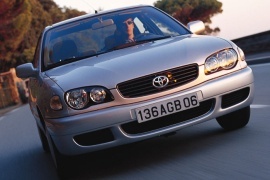
Five years after introducing the Corolla’s fifth generation, Toyota unveiled a mid-life cycle refresh for the compact-segment vehicle.
Being one of the best-selling nameplates in the world was a tough challenge for the Japanese carmaker, who tried to keep the Corolla’s sales figures up. It managed to be the top-selling car in 1997. Three years later after that achievement, Toyota unveiled a facelifted version for its compact-sized vehicle.
Finally, all the Corolla family had the same front fascia, and that made things easier for the carmaker to produce and for customers to recognize them. Toyota extended the double headlamps system from the sedan for the five-door version as well. That led to a redesigned grille with horizontal slats and a new wrapped-around plastic bumper that sported a lower grille and a pair of side-scoops. At the back, the five-door version was not the best-inspired one. Its sloped tailgate didn’t help too much for increased trunk space and, from the design point of view, was not that appreciated either.
Inside, the designers changed the dashboard completely. They installed a small LCD on top of the center stack and buttons around it. It was used for the audio system as an ancestor for the infotainment systems. The instrument panel was different, depending on the engine option, with or without a tachometer. It was not on top of its class with 372 liters (13.1 cu-ft) of trunk space.
Under the hood, Toyota installed a small range of engines consisting of a 1.6-liter gasoline unit and two diesel versions: a 1.9-liter carried over from Peugeot-Citroen, and a 2.0-liter turbo-diesel developed in-house.
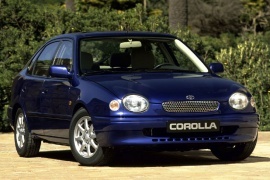
Already famous for their great reliability and excellent value for money, the Corolla range was updated in 1997.
Guiding their evolution process on the “If it’s not broken, don’t fix it” idea, Toyota managed to keep Corolla’s position on the market, thus it was awarded the world’s best selling car title in 1997.
The 5-door liftback was upgraded along with the 3-door hatchback, the estate and the saloon body styles.
A world car, the Toyota Corolla was sold in three different markets: Japan, North America and Europe.
While the previous models were greatly appreciated, Toyota noticed the customer’s need of a more fun-to-drive vehicle, thus excitement needed to be a word to define the new generation.
The new models came with a changed suspension, new fabrics inside, more lively design elements and a heavily redesigned exterior look, with revised headlights, a new grille and new taillights. The redesigned exterior also helped reducing the NVH levels with its flush-mounted side windows and other techniques borrowed from Lexus.
Other changes included new technical specifications and well as more equipment.
Both gasoline and diesel units were available, however, the Japanese market had a broader range of engines to choose from. Most Corollas were powered by a 1.8-liter all-aluminium DOHC 4-cylinder engine that developed 120 hp and 122 pound-feet of torque. Besides more power offered, the engine helped achieving a lower fuel consumption than its predecessor.
Concerned about safety, Toyota offered the Corolla with four-wheel antilock brakes and side-impact airbags.

The curved lines trend in the automotive design affected the boxy-looking Corolla from the seventh-generation and lowered its drag resistance.
Toyota changed its strategy and increased the size of the seventh-generation Corolla range. The car was offered in various shapes and sizes, from a 3-door hatchback to a station-wagon with high-roof. The 5-door hatchback was a trendy choice due to its practicality.
Since the straight-cut design was almost gone and the carmakers started to rounded-up vehicles, Toyota followed that way as well. The seventh-generation of the Corolla featured smoother lines, which made the car decreased its Cx drag-coefficient as low as 0.30 for the fastback version. Its headlights were slim and covered the corners for some versions. In Australia, it featured round headlights, similar to those installed on the 3-door hatchback. A narrow grille below the hood was not enough to cool bigger engines, so an additional one was mounted in the lower bumper area. Behind the rear doors, it featured another small window and a raked D-pillar. At the back, Toyota installed more prominent taillights on the quarter panels and the tailgate.
The dashboard featured an extended instrument cluster, curved, which enhanced the visibility to the four-dials panel. Since it was built for young families, it offered a fair interior space for two adults and two children, with a pair of seats at the front and a bench in the back. For the base trim levels, the Corolla featured power-steering, power brakes, and a stereo-cassette.
Toyota fitted the Corolla five-doors with a choice of four engines, both gasoline, and diesel. All versions were paired as standard with a 5-speed manual. For selected markets and engine versions, a 4-speed automatic was on the options list.
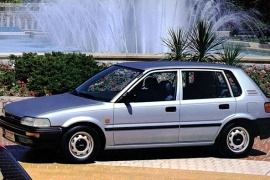
In the mid-80s, Toyota raised the bar and changed the game, noticing people’s desire: a car that would do more than just taking its occupants from A to B.
The new Corolla came to life under the newly promoted development leader Akihiko Saito’s supervision. His vision was pretty simple and complex at the same time, as he stated to his team: “I believe that the Corolla must erase the image of family cars of the past. Wouldn’t it be nice if the quietness and ride comfort of the Crown and the attractive appearance of the Mark II were achieved in a vehicle the size of the Corolla?”
With this idea in mind, the team focused on developing a powerful design regardless of the body style, while the new Corolla also had to be fun to drive.
Aesthetically, the new Corolla was wide and low, with more rounded edges compared to the previous generations. To give the impression of a luxurious vehicle, the A and C pillars were pulled closer together, and, for the five-door version, the carmaker installed an additional set of windows behind the rear doors.
Toyota considered people’s opinions regarding interior design. Thus, they visited their customers to better understand what they were looking for: a note of luxury and increased comfort. The Corolla featured velour and thick-knitted fabric materials. Optionally, customers could choose a maroon interior color scheme that was rather seen in the most luxurious vehicles of the time.
All controls allowed easy operation, while Toyota gave great attention to the switches’ feel, besides the overall well laid out instruments.
All body styles available were offered with a front-wheel-drive system, which was rather unusual for Toyota, as their previous generations mostly featured a rear-wheel-drive system.























































